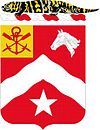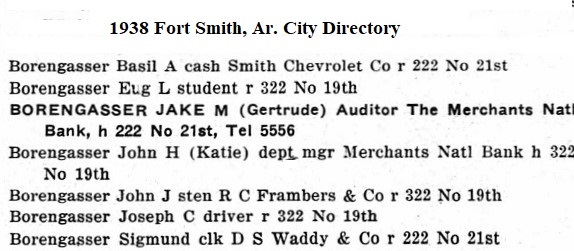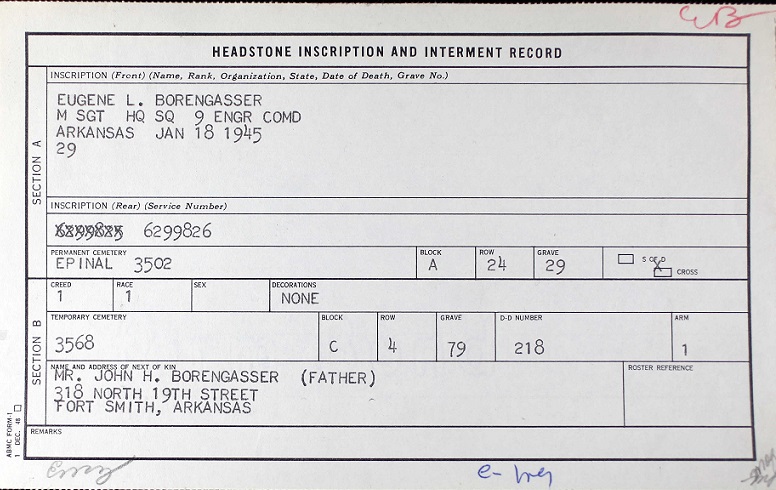Sgt. Eugene L. Borengasser
1920/1-1945
Eugene L Borengasser was born about 1921 in Fort Smith, Sebastian Co., Ar. to
John Herman & Katie M. Schlaf Borengasser. He is listed as a widower without dependents on his enlistment.
(I have not located a marriage for him)
Eugene's occupation before enlisting was Mechanic.
M/Sgt Borengasser was attached to 9th Engineer Command, Headquarters Squadron.
On January 18, 1945 he died from Non-battle causes.
Master Sergeant Borengasser was a passenger on a plane which crashed at Le Plessis-Gassot in France.
The plane took off from A-54C at 0935 for AAF-343 with a load of passengers and crashed approximately
seven minutes later. The crash was fatal to eighteen of the twenty two occupants of the plane and the
other four persons were all seriously injured. The plane was completely demolished by the crash. There
were no witnesses and the four surviving passengers were unable to remember anything that could help
determine the cause of the accident. Although the accident was thoroughly investigated by an accident
committee, they were unable to determine the cause of the crash.
All crewmembers were killed; Pilot 2nd Lt Roy J. Shilling, Co-pilot 2nd Lt George A. Wood, Radio
Operator Cpl Alphonse V. Cogozza and Engineer Cpl Harold W. Grubb.
Other passengers of this aircraft who are buried at the American War Cemetery at Epinal are: M/Sgt
Roamy E. Dandrige, T/Sgt Robert J. Simon, T/5 Angelo J. Lavenia and S/Sgt Henry J. Coon.
The crew and passengers were initially buried at Solers Cemetery at Melun, France.
M/Sgt Borengasser is buried at Plot A Row 24 Grave 29, Epinal American Cemetery, Epinal, France.

9th Engineer Battalion coat of arms
The 9th Engineer Battalion is a unit of the United States Army that deploys to
designated contingency areas and conducts combat and/or stability operations in support
of a brigade combat team. It is a divisional mechanized combat engineer unit, composed
of three line companies and a headquarters company. Its mission is to provide assured
mobility, counter-mobility, general engineering, and survivability support with well
trained sappers (combat engineers) ready to deploy anywhere at any time. The unit’s
history spans service in 1917 in the US southwest, World War II in France and Germany.

WWII Army and Army Air Force Casualty List


|
|
|
|